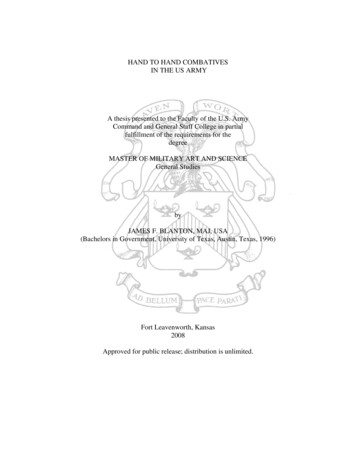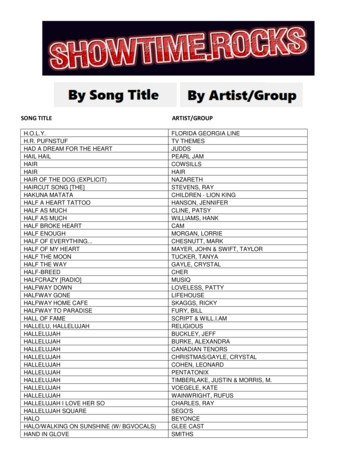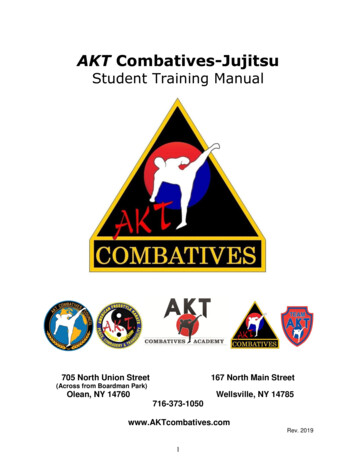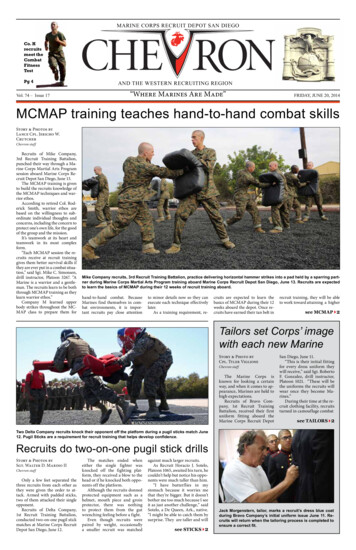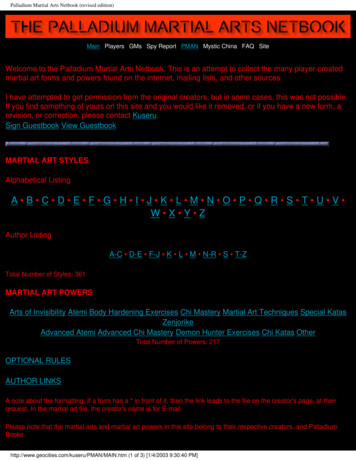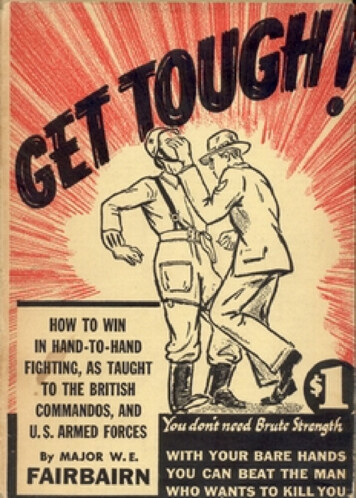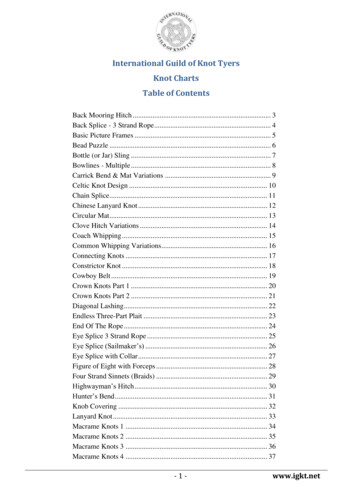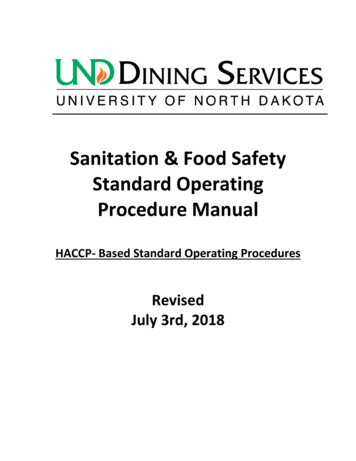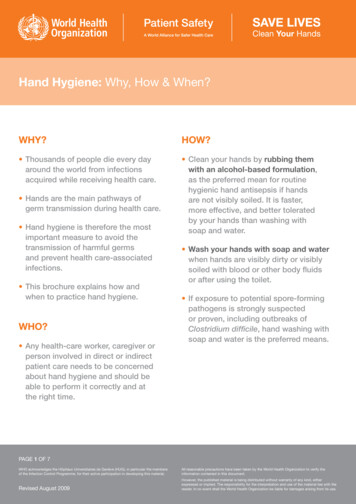
Transcription
HAND TO HAND COMBATIVESIN THE US ARMYA thesis presented to the Faculty of the U.S. ArmyCommand and General Staff College in partialfulfillment of the requirements for thedegreeMASTER OF MILITARY ART AND SCIENCEGeneral StudiesbyJAMES F. BLANTON, MAJ, USA(Bachelors in Government, University of Texas, Austin, Texas, 1996)Fort Leavenworth, Kansas2008Approved for public release; distribution is unlimited.
REPORT DOCUMENTATION PAGEForm ApprovedOMB No. 0704-0188Public reporting burden for this collection of information is estimated to average 1 hour per response, including the time for reviewing instructions, searching existing datasources, gathering and maintaining the data needed, and completing and reviewing this collection of information. Send comments regarding this burden estimate or anyother aspect of this collection of information, including suggestions for reducing this burden to Department of Defense, Washington Headquarters Services, Directorate forInformation Operations and Reports (0704-0188), 1215 Jefferson Davis Highway, Suite 1204, Arlington, VA 22202-4302. Respondents should be aware thatnotwithstanding any other provision of law, no person shall be subject to any penalty for failing to comply with a collection of information if it does not display a currently validOMB control number. PLEASE DO NOT RETURN YOUR FORM TO THE ABOVE ADDRESS.1. REPORT DATE (DD-MM-YYYY)2. REPORT TYPE3. DATES COVERED (From - To)12-12-2008Master’s ThesisFEB 2008 – DEC 20084. TITLE AND SUBTITLE5a. CONTRACT NUMBERHand to Hand Combatives in the US Army5b. GRANT NUMBER5c. PROGRAM ELEMENT NUMBER6. AUTHOR(S)5d. PROJECT NUMBERMAJ James F. Blanton5e. TASK NUMBER5f. WORK UNIT NUMBER7. PERFORMING ORGANIZATION NAME(S) AND ADDRESS(ES)8. PERFORMING ORG REPORTNUMBERU.S. Army Command and General Staff CollegeATTN: ATZL-SWD-GDFort Leavenworth, KS 66027-23019. SPONSORING / MONITORING AGENCY NAME(S) AND ADDRESS(ES)10. SPONSOR/MONITOR’SACRONYM(S)11. SPONSOR/MONITOR’S REPORTNUMBER(S)12. DISTRIBUTION / AVAILABILITY STATEMENTApproved for Public Release; Distribution is Unlimited13. SUPPLEMENTARY NOTES14. ABSTRACTAn analitical review of the present state of modern army combatives, how it compares to thecombative systems of other US military services and foreign militaries. The guidance fortraining combatives, what training is coducted and the application of the training in combat.Finally any recommendations for improvements to the modern army combatives programs.15. SUBJECT TERMSHand to Hand Combatives, Modern Army Combatives Program, Marine Corp Martial ArtsProgram, Air Force Combatives Program, Sambo, Krav Maga, Tae Kwon Do, Tukong Moosul16. SECURITY CLASSIFICATION OF:a. REPORTb. ABSTRACTc. THIS PAGE(U)(U)(U)17. LIMITATIONOF ABSTRACT18. NUMBEROF PAGES(U)10619a. NAME OF RESPONSIBLE PERSON19b. PHONE NUMBER (include area code)Standard Form 298 (Rev. 8-98)Prescribed by ANSI Std. Z39.18ii
MASTER OF MILITARY ART AND SCIENCETHESIS APPROVAL PAGEName of Candidate: MAJ James F. BlantonThesis Title: HAND-TO-HAND COMBAT IN THE US ARMYApproved by:, Thesis Committee ChairMr. Michael Langley, MA, MemberLTC Martin F. Adams, MA,MemberCOL Kendra Kattelmann, Ph.D.Accepted this12th day of December 2008 by:, Director, Graduate Degree ProgramsRobert F. Baumann, Ph.D.The opinions and conclusions expressed herein are those of the student author and do notnecessarily represent the views of the U.S. Army Command and General Staff College orany other governmental agency. (References to this study should include the foregoingstatement.)iii
ABSTRACTHAND-TO-HAND COMBATIVES IN THE U.S. ARMY by MAJ James F. BlantonThe Modern Army Combatives Program was adopted by the U.S. Army in 2000.The program is the culmination of a directive by the Commander of 2nd Battalion, 75thRanger Regiment in 1995 to improve the Army’s older and unused combatives program.Modern Army Combatives is a ground based fighting system that teaches soldiers toclose the gap between him or herself, gain dominance and finishes the fight. Theprogram’s roots are in Brazilian Jujitsu, but is this the right program for the averagesoldier on today’s battlefield? The attempt to answer this question was conducted by firstanalyzing the Army’s program, then examining the Marine Corps, the Air Forces, theRussian military, the Israeli military, and the Korean military programs. Each forcesprogram was then compared to Modern Army Combatives. In order to support the thesisof this paper, surveys and interviews from various organizations within the Army wereconducted and in-depth interviews with martial arts experts from outside the militarywere used to provide a greater depth to the research. The current program has set thestage very well for the Army’s hand-to-hand training, but through the half a dozenchanges recommend in the thesis it can only get better.iv
ACKNOWLEDGMENTSI would like to acknowledge and thank the following individuals or groups, withoutwhose assistance I would not have been able to write this thesis.Mr. Michael L. LangleyCOL Kendra KattelmannLTC Martin F. AdamsMr. George F. ChandlerGrandmaster Young Hak Lee, Tae Kwon Do, Lacey, WAMaster Jason Lee, Tae Kwon Do, Lacey, WAMr. Kelly McCannMr. Scott Anderson, SamboLtCol Kevin Adelsen, USAFMr. Matt Larson, US Army Combatives School, Ft. Benning, GAMSGT Coleman, USMCGySgt Friend, USMCSGT Flynn, US Army Combatives School, Ft. Benning, GAMr. Steve Woolridge, Krav MagaSoldiers, NCOs, Officers of 2-3 IN and 1-14 CAV, 3-2 SBCT, Ft. Lewis, WAMaster Ali, Tukong Moosul, Austin, TXMaster Pae, Tae Kwon Do, Lakewood, WAStudents and Faculty of CGSCMAJ Joe Reap, 192d Inf Bde S3, Ft Benning, GACPT Reed Burggrabe, 1-11 IN S3, Ft Benning, GAv
TABLE OF CONTENTSPageMASTER OF MILITARY ART AND SCIENCE THESIS APPROVAL PAGE . iiiABSTRACT . ivACKNOWLEDGMENTS .vTABLE OF CONTENTS. viACRONYMS . viiiILLUSTRATIONS . ixCHAPTER ONE INTRODUCTION .1Introduction . 1Significance of a Hand-to-Hand Combatives Program . 7Assumptions. 8Limitations . 9Delimitations . 10CHAPTER 2 LITERATURE REVIEW .14CHAPTER 3 RESEARCH METHODOLOGY .24CHAPTER 4 ANALYSIS.31Jujitsu . 32Modern Army Combatives Program. 32Marine Corps Martial Arts Program . 40MCMAP Comparison . 44Air Force Combatives Program . 45AFCP Comparison . 47Sambo . 48Sambo Comparison . 54Krav Maga . 55Krav Maga Comparison . 61Tae Kwon Do/Tukong Moosul . 62Korean Martial Arts Comparison . 68General Comparative Analysis . 69CHAPTER 5 CONCLUSIONS AND RECOMMENDATIONS .82vi
Introduction . 82Conclusions . 83Recommendations . 89Areas of Further Study . 92Summary . 92APPENDIX A SURVEYS.94APPENDIX B APPROVAL MEMORANDUMS .101REFERENCE LIST .102INITIAL DISTRIBUTION LIST .106vii
ACRONYMSAFCP – Air Force Combative ProgramARFORGEN – Army Force GenerationCSAF – Chief of Staff of the Air ForceFM – Field ManualH2H – Hand to HandL.I.N.E. – Linear Infighting Neural-Override EngagementMACP – Modern Army Combatives ProgramMCMAP – Marine Corps Martial Arts ProgramMMA – Mixed Martial ArtsNCO – Non-commissioned officerMOS – Military Occupational SkillPOI – Plans of InstructionROTC – Reserve Officer Training CorpsSOF – Special Operations ForceSSG – Staff sergeantTTP – Tactics, Techniques and ProceduresUFC – Ultimate Fighting ChampionshipUSAF – United States Air ForceUSMC – United States Marine Corpsviii
ILLUSTRATIONSPageFigure 1. Vital Targets.35Figure 2. Rear Mount .39Figure 3. Continuum of Force .43Figure 4. Pressure Points of the Body .44Figure 5. Lever over the forearm.52Figure 6. Counter to lever over the forearm .52Figure 7. Twisting arm knot against the overhead knife attack .53Figure 8. The rear stepping throw- front, rear and side stepping throws were the “workhorses” of Sambo endorsed by both Spiridonov and Oshchepkov .53Figure 9. Method for taking down a sentry from behind followed by a strangle hold.54Figure 10. How much personal experience do you have with the Modern ArmyCombatives Program (MACP)? .71Figure 11. Do you feel that there is a definitive requirement for every Soldier, regardlessof rank, branch or gender, to train in a hand-to-hand combatives trainingprogram, such as MACP? .71Figure 12. Level of Last Assignment .72Figure 13. Level of Command Emphasis for MACP Training in Your Last Unit .72Figure 14. In Your Last Unit, How Much Training Did Your Unit Do in MACP PerMonth .73Figure 15. In Your Personal Opinion, What is the MOST SIGNIFICANT Challenge inTraining on MACP? .74ix
CHAPTER ONEINTRODUCTIONIntroduction1–23. Army combatives traininga. Combatives is the instruction of hand–to–hand and rifle–bayonetfighting and is key in ensuring Soldiers are mentally prepared to engage and killthe enemies of the United States in close combat. The Army combatives trainingenhances unit combat readiness by building Soldiers’ personal courage,confidence, discipline, and the unit’s esprit de corps. The dynamics of a fullspectrum combat environment demands that Soldiers have the courage,confidence, and competence to implement controlled aggression to use theminimum amount of force to control the situation. It also improves Soldiers’ability to remain focused under duress. A successful combatives training programwill empower Soldiers with the ability to conquer fear and anger, allowing forcontrolled actions and enhanced situational awareness.b. Commanders in both the operational and institutional domains willimplement a combatives training program that certifies safe and professionalcombatives training and competitions.(1) Institutional domain commanders will schedule a minimum of 10hours of combatives instruction training initial entry Soldiers on the principals ofcombatives and basic combatives skills during IET.(2) Operational domain commanders will schedule more advancedcombatives training to build upon combatives skills learned in IET. Commandersshould program combatives in collective training events to ensure Soldiers applythe appropriate level of combatives to control the situation.c. This regulation establishes Army policies for combatives training andFM 3–25.150 serves as the instructional guide for combatives training.Headquarters Department of the Army, AR 350-1In 2004 the Army underwent a fundamental change to its ideology. Every Soldierwould be viewed as a warrior regardless of their military occupational specialty (MOS)and the Forty Warrior Core Tasks were created. In the Forty Warrior Core Tasks handto-hand fighting is listed as react to man-to-man contact, and considered an integral partof the Army’s Warrior Ethos initiative. This also represents a change in the way theArmy views combatives. Since Modern Army Combatives Program’s (MACP) inceptionin 1995, the program has slowly grown in vogue throughout the Army. So, it begs the1
question: “After more than a decade of existence, what is the status of the programtoday?” Does the Modern Army Combatives Program, as it currently exists today and isdesigned, meet the needs of all Soldiers, prepare our Soldiers to engage in successfulhand-to-hand combat encounters on today’s battlefield? This thesis will look at howMACP has evolved since World War II, and why Soldiers need a formalized, efficientand effective combatives training program. The training involved in MACP, the basicskill sets of the program, and the basic proficiency levels to be achieved must beexamined. The training will be looked at from the perspective of the Combatives Schoolat Ft. Benning, basic training units, and regular Army units. The training aspect will alsoevaluate the present training guidance on various Army levels. This thesis will also lookat how Modern Army Combatives compares against other US military service programsand foreign military programs, specifically Korea, Israel, and Russia.The purpose of this study is to investigate the adequacy of MACP to prepare aSoldier to engage and defeat an enemy in hand-to-hand combat situations on today’sbattlefield. This study will examine the hand-to-hand combatives utilized by the UnitedStates military services, and compare and contrast the Army’s combatives program to theMarine and Air Force programs. The training plan for Soldiers learning combatives andhow commanders and trainers apply that plan during the Army Force Generation(ARFORGEN) cycle will also be examined. Finally, this study will use the militarycombatives taught in the Israeli Defense Force, the Korean Army, and the Russian Armyto compare and contrast MACP. By putting all of these aspects of military combativestogether, this study hopes to identify the strengths and potential improvements for theModern Army Combatives Program.2
Military combatives is the system of hand-to-hand fighting developed for U.S.military personnel. Combatives are trained in garrison or while deployed so that militarypersonnel have the capability to attack or defend themselves without a firearm in battle.On the battlefield, in the event that Soldiers either cannot employ their firearms, or theirfirearms cease to function, combatives allow Soldiers to use only their hands or animprovised weapon to subdue or kill an attacker. Combatives can include many aspectsranging from punches and kicks, throws and sweeps, joint manipulation (the twisting,bending, or pulling of specific joints, usually wrist, elbow, shoulder or ankle, in order tocause pain or subdue ones opponent), and ground fighting (fighting that takes place whilethe combatants are on the ground). Combatives can include open-handed attacks (noweapon), knives, sticks, or any available object that Soldiers can use to defendthemselves.Today’s Soldiers face a complex battlefield. The urban battlefield is a 360 degreeenvironment. Combatants can be mixed in with non-combatants. Soldiers can be askedto conduct a full range of missions from passing out blankets, to raids, to personalsecurity. Although Soldiers may face a hand-to-hand combat situation in any combatenvironment, the urban environment presents a significantly higher threat to a Soldier,with the dense population and restrictive nature of the terrain. Today, with more of theworld’s population urbanized, Soldiers will increasingly operate within the populatedurban environment. In Iraq and Afghanistan, today’s Soldiers must personally interfacewith the population to gain trust and to limit the insurgents influence over the population.In order to prepare them for the mission, today’s Soldiers have been equipped with someof the most advanced gear available. The combat vests they wear have four ballistic3
plates for projectile penetration prevention, the capacity to carry not only the basic loadof ammunition in seven magazines, but carry even more ammunition, emergency medicalkits, demolition kits, and other essential gear. Due to these enhancements in individualSoldier protection, this combat load makes the average Soldier better able to survive, butit also encumbers him when faced with a hand-to-hand fight. In the urban environment,Soldiers run the risk of encountering angry mobs, demonstrations, protests, or armedinsurgents who have blended in with the population in order to get close enough to U.S.Soldiers in order to wound or kill them. These situations are frequently encountered bySoldiers who are not traditionally trained in the combat arms. On today’s battlefield,female Soldiers are just as likely to come into contact with the enemy as males. In Iraqand Afghanistan, summer temperatures can reach over 120 F, which quickly fatigueseven the strongest and well conditioned Soldier. Under all of these conditions, given anenemy who can strike anywhere, or a situation that can become volatile without warning,U.S. Army Soldiers must be able to defend themselves and apply the force necessary toprevent their injury or death, or the death of a fellow comrade. Army combatives trainingshould address all of these situations, with a training regimen that can be easilyincorporated into any unit’s training plan as they prepare for deployment and maintainedwhile deployed for extended periods.Beginning in either basic training or the officer basic course, U.S. Army Soldiers,today, both enlisted and officer, are taught MACP. In addition, MACP is taught throughall levels of the non-commissioned officer education system and in all Captains CareerCourses. MACP trains Soldiers to become more aggressive in their warrior skills andinstills in them the confidence that they are lethal with their bare hands, and not with just4
their weapon, whether a rifle, pistol, or bayonet. In 1995, Army Combatives was a littletrained, seldom-used system of unarmed combat. It was characterized by dynamicthrows and skillful joint manipulation techniques. It had its history in the techniquestaught during World War II by men like William Fairbain, Eric Sykes and Rex Applegate(FMFRP 12-80, 1991). FM 21-150, The Army Combatives Manual, was first publishedin 1942, and changed very little over the next 50 years.MACP was initially designed for the 75th Ranger Regiment. The Ranger’s aremanned by specially trained Soldiers, known for their extreme physical and mentaltoughness and indomitable fighting spirit. The Ranger’s are a specially trained unit, withaccess to unique resources, and with a unique mission not common to the average Armyunit. Their mission, set by the highest levels of the Department of the Army andDepartment of Defense, demand that every Soldier within the 75th Ranger Regiment becapable of accomplishing whatever mission assigned, at any time and any place, and notfail to accomplish his set objectives. Due to this intense demand, they demanded therequirement for an intense combatives training program to be developed andimplemented into the unit.When 75th Ranger Regiment researched a way to revolutionize their combativesprogram, they turned to a proven fighting system in Gracie Jujitsu. In 1993, Mr. RoyceGracie took the world of ultimate fighting by storm and introduced Gracie Jujitsu.Ultimate fighting, or mixed martial arts (MMA) is a hybrid martial art that allows almostany technique to be used during a competition. This is includes striking with the hands,feet, elbows, and knees, or grappling and ground pounding (sitting on a person’s chestwhile they are on the ground and punching them until they submit or are knocked out).5
MMA has rules that prohibit strikes to the groin, neck, back of the head, or eye gouges,as well as others to protect the fighters. With this unique fighting skill, first pioneered byRoyce Gracie’s grandfather Gastao Gracie, Royce Gracie was able to defeat opponentsoutweighing him by 50 or more pounds. Even today, Royce Gracie retains the no-holdsbarred (a match without restrictions or rules) record of defeating four opponents in onenight (Official Site of Royce Gracie Biography). The Gracie Jujitsu revolution had fullyarrived, and in today’s mixed martial arts world, no professional fighter will survive forvery long without possessing an expertly-skilled, finely-honed ground-fighting game.The flaw with adopting the Gracie Jujitsu style of martial arts for militarycombatives is that it is inherently a ground-based fighting system. While Jujitsu is a verypowerful and effective form of fighting, it has severe limitations when applied todemands of the military. At its basic level, Jujitsu is an extremely technical skill. Jujitsumatches are played like a human chess game between two people. These skills take asignificant amount of time to learn, and then additional time spent to hone for use inactual fighting engagements. Jujitsu essentially requires unencumbered flexibility, whichis not always the case on the modern battlefield. A modern Soldier in a combatenvironment is oftentimes encumbered, burdened with the stress of wearing upwards of75 pounds plus of “lightweight” combat and survival gear for the conduct of his assignedmission. Finally, Jujitsu is very effective against a single opponent in a situation wherecombatants, fighting on the ground are without risk of being attacked by another attacker,this is not always the situation encountered on the modern day battlefield.6
Significance of a Hand-to-Hand Combatives ProgramSoldiers, regardless of their job in the Army, are required to be trained on basicmarksmanship and core battle drills (the Forty Warrior Core Task, of which react to manto-man contact is one, embodies this ethos). Regardless of their rank, age, or sex, allSoldiers should be able to defend themselves without relying upon a weapon of any kind.Any combatives program should be simple to learn, simple to train and maintain, andprovide the individual with the diversity of skills they need to survive on the battlefield.In a crisis people respond through either the fight or flight reaction, and especially byhow they have been trained and conditioned to respond. When an animal is confrontedwith a threat or a stressful situation, the natural inclination of “fight or flight” reactiontakes over. This response is inherent in all animals, especially that of humans, and ischaracterized by a marked increase in heart rate, rapid breathing, tunnel vision, andreduced mental capacity. Fight or flight supercharges the body into hyperactivity,capable of feats of incredible strength and speed. This natural response to dangerrequires the expenditure of a huge amount of energy, and cannot be maintained for everylong (Neimark, 2008). The body’s reaction would impair a Soldier’s ability to performcomplicated moves requiring the ability to clearly think and reason. As such, moderncombatives should require gross motor skills, trained to create muscle memory so thatwhen a Soldier’s adrenaline is pumping because he or she is literally fighting for theirlives, they will react instinctively. On today’s battlefield, be it either Iraq, Afghanistan,or any one of the eighty-some odd countries the U.S. Army finds itself in today, Soldierswill most likely encounter situations dealing with crowds, whether passive or hostile,whose moods and posture can change without warning. Modern combatives should7
address such volatile situations and train Soldiers in how to cope with multiple attackerscoming from multiple directions, and the ability to defeat them.In a combat situation, Soldiers are weighed down by at least 50-75 pounds ofequipment, if not more. A Soldier’s combatives skill should not default towards takingan attacker from the standing position down to the ground, where both attacker anddefender are on the ground, if at all possible. In combat, once a hand-to-hand fight goesto the ground, surrounded by a hostile crowd, Soldiers are at an extreme disadvantage.This disadvantage is defined as Soldiers not being able to break contact, or beingvulnerable to attacks by others while they are engaged on the ground. Also once a fightgoes to the ground, a Soldier is fully committed until he either kills or submits hisopponent or he is killed or subdued. The results of this study will assist the Army’scombatives school at Ft. Benning, Georgia with evaluating the techniques that are beingtaught to Soldiers and trainers. The study will allow trainers to evaluate how theyconduct combatives training and how they can improve the survivability of their Soldiers.AssumptionsU.S. Army Soldiers will always have a need for some type of hand-to-handcombat skill. The nature of warfare, from the Spartans during the Peloponnesian War totoday’s Soldiers on the streets of Baqubah and Kandahar, will always be one ofuncertainty, chaos, and violence. Soldiers will have to react instinctively towardsdeveloping situations and threats regardless of the other conditions around them oraffecting them. This will require specific skills outside of simple self-defense techniques,cultural art forms, or competitive sports which many martial arts styles fall under.8
The Army will resist changes to its combatives program. The average Soldierdoes not spend an adequate amount of time training on combatives. Qualified MACPtrainers are in short supply, and it takes an inordinate amount of time to get a trainerqualified. With the condensed timeline most units face to re-equip, rearm, and conducttrain-up for the next combat rotation into theater, there is not enough time to dedicate to atechnical system such as Jujitsu.LimitationsThis research will address only fighting systems developed specifically forSoldiers, systems that involve both offensive and defensive techniques. The research willbe limited by the time allotted by the United States Army Command and General StaffCollege. The time limitation does not permit actual training in every combative stylementioned in the research. Therefore past experience, interviews, and surveys withexperts in the styles will have to be substituted for hands-on participation in every stylementioned in this thesis. Much of the information available is written in support of onestyle or another. Priority for any participation in a combatives style will go to theModern Army Combatives Program. Kansas State University and Fort Riley, Kansasboth have a Level Four MACP instructor, the highest skill level achievable in MACP.Time and funds permitting, enrolling in either Level One and/or Level Two will bepriority. MACP levels will be further explained in chapter four of this paper. Generalinformation on this topic is readily available through either the research library or online.Most research tends to focus on only one style, so the comparative part
program was then compared to Modern Army Combatives. In order to support the thesis of this paper, surveys and interviews from various organizations within the Army were conducted and in-depth interviews with martial arts experts from outside the military were used to provide a greater depth to the r
